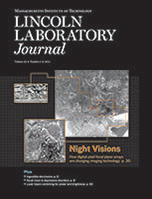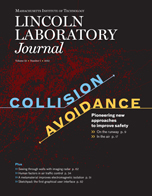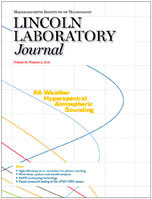Publications
Lab Notes
Lab Notes are brief, nontechnical descriptions of some of Lincoln Laboratory's most intriguing engineering innovations and their potential impact.
Lab Notes from Volume 22, Number 1
Published July 2016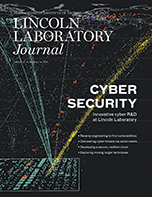
- Securing Data › A novel technology simplifies secure military communications and has the potential to be beneficial for a wide array of applications.
- Keeping an Eye on Cyber Threats › Researchers use real-time data from Lincoln Laboratory networks to monitor and develop countermeasures against cyber threats.
- Training the Cyber Defensive Line › A game-like competition is helping build experts in cyber "disaster response."
- Can a GameTeach Practical Cyber Security? ›
Lincoln Laboratory's Capture the Flag competition challenges college students to defend cyberspace. - Recruiting the Next Generation of Cyber Security Specialists › Two Lincoln Laboratory outreach activities seek to steer high-school students toward careers in cyber security.
Lab Notes from Volume 20, Number 2
Published August 2014
- Load-Sensing Boots › Instrumented footwear technologies present new possibilities for tracking and preventing lower-limb musculoskeletal injuries.
- It's All in the Design › An exercise in visual analytics informs the approach for developing future usable network monitoring interfaces.
- Ingestible Biosensors › An electronic "pill" could optimize physiological status monitoring.
- Beyond What the Words Say › Vocal features may predict the severity of depressive disorders.
- Evolutionary Radar—Sensing for Survival › Lincoln Laboratory investigators tracked down an intriguing sensor whose performance was postulated to be much better than that of our nation's 1960s-era radars.
Lab Notes from Volume 19, Number 1
Published July 2012
- All Versus All Conjunctions › Weaving through a minefield of objects in Earth orbit is getting more difficult.
- Nanowire Single-Photon Detector Arrays › Detect a billion photons per second with low noise and high efficiency.
- Runway Status Lights › Protecting aircraft when they are most vulnerable—during takeoff and landing.
- Ultrasensitive Two-Dimensional Photodetection › What information can be associated with the detection of a single photon?
- The TX-2 Computer and Sketchpad › Early computer technology at Lincoln Laboratory led to computer graphics and the functionality of your touchpad
Lab Notes from Volume 18, Number 2
Published May 2010
- A Bright Idea › Simple tweaks turn tiny diode lasers into powerhouses.
- Let a Robot Do the Work › They're not automatons, but these robots map, track, and locate things for you.
- Uncoiling DNA Analysis › Rapid DNA-fingerprinting method would identify biological organisms in the field.
- A Route to Energy Savings › Predictive control of plug-in hybrid vehicles will analyze your route to work and optimize battery and gas usage.
- Vision Correction › Two projects should help astronomers see further across the universe.
- Wideband Radar › Lincoln Laboratory reseaerchers built the world's first long-range wideband radar and launched a new era in defense radar and satellite imaging capability.
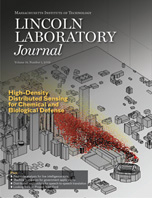 Lab Notes from Volume 18, Number 1
Lab Notes from Volume 18, Number 1
Published August 2009
- Foul-Weather Friend › The Corridor Integrated Weather System now covers the continental U.S., expanding air traffic planners' and airline dispatchers' view of the nation's weather.
- Going Beyond Limits › New lens lets microscopes peer at smaller objects.
- Early-Warning Chemical Sensors Pass an Indoor Test › A relatively cheap sensor system can detect indoor chemical weapons attacks.
- A Fast Switch › Work on a high-speed optical switch could provide one component for future communications networks.
- Dialect Detectives › Systems that distinguish among variants in spoken language could enhance automated machine translation.
- Radio Wave of the Future › Modeling of communications protocols helps the military design next-generation software-defined radios.
- Space Needles › Project West Ford proved that survivable communications were possible.
 Lab Notes from Volume 17, Number 2
Lab Notes from Volume 17, Number 2
Published November 2008
- Auto-mation › A robotic car bedecked with Lincoln Laboratory sensors takes on DARPA's Urban Challenge.
- "Nano-urchins" Could Save Soldiers' Eyes › Novel materials darken quickly when hit by intense light, such as from a stray laser beam.
- Cruising the Energy Bands › New kind of atomic probe could be boon for quantum computing.
- Standing Guard › Protecting process control systems: Q&A with Robert Cunningham.
- Looking for a Reaction › A new DNA amplification method is better, faster, and cheaper than traditional tests.
- A Big Eye Sees Small Things › An upgrade to the Millstone radar antenna will ensure uninterrupted tracking of the ever more crowded geosynchronous orbit.
- Plugging the Right Holes › NetSPA software maps computer networks to find paths most vulnerable to hacking.
- Untangling the Friendly Skies › Computer recommendations could clear up some weather-caused airline delays.
- Good Vibrations › A different take on terahertz radiation can measure moving motors or beating hearts.
- Threat Detection › Cheap sensors plus mesh networking could yield an effective alarm system for biological and chemical attacks.
- Order from Chaos › Human factors engineering adds value to complex systems by making them seem simple to the user.
- Conceiving Collision Avoidance › Lincoln Laboratory proved that unfeasible was not the same as impossible.
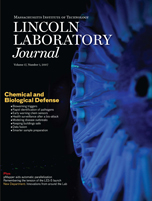 Lab Notes from Volume 17, Number 1
Lab Notes from Volume 17, Number 1
Published November 2007
- Pump on a Chip › A microfluidic lab-on-a-chip moves tiny volumes of fluids around on a silicon chip without the use of external pumps and valves.
- Small Packages › A new way to squeeze compound semiconductors onto silicon chips promises smaller, more efficient microelectronics.
- Power to Go › Integrating a thermovoltaic device with a butane-fueled combustor yields an efficient source of portable power to challenge batteries.
- A Little Light Work › Getting silicon to respond to light could usher in a new era of integrated optical devices.
- No More Babel? › An algorithm that accounts for parts of speech lowers a key barrier to real-time language translation.
- Detector Avoids Speed Traps › Photodiodes sensitive around 1.9 micrometers could sense biological and chemical agents.
- Shadowy Work › Arrays of telescopes figure out what satellites are doing by looking at their silhouettes.
- Saving a Satellite › Forty years ago, a Lincoln Laboratory team spent agonizing hours waiting for a pioneering UHF communications satellite to wake up.
top of page

